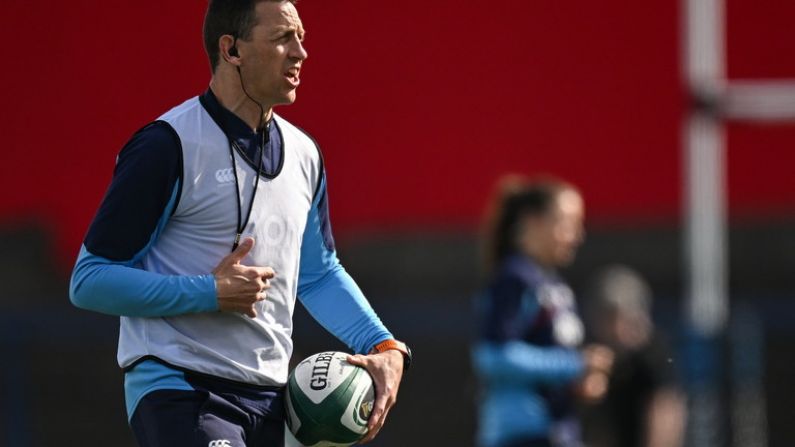It was one of those Sunday mornings where you wake up and ask did that really happen? Or was it merely some glorious dream inspired by years of yearning and desire.
But it did happen. Ireland did beat the All Blacks and how. Not only did Joe Schmidt’s team end the longest winning run of any tier one Test team with 18 victories, they did it in style.
Statistics can divide opinion as to their true bearing on a game, but some stand out very clearly from yesterday as to how and why Ireland were able to perform as well as they did against the very best opposition in the world.
The first is Ireland’s try count with five on the board. Scoring five tries against New Zealand is not just impressive it’s goddam unheard of in recent times. The All Blacks conceded just six tries in total during the Rugby Championship this season, making Ireland’s feat all the more noteworthy.
Ireland use first-half dominance and ruck and maul to secure win
When you drill down into the statistics of how Ireland won the match it is even more remarkable. New Zealand totally dominated Ireland in the ball-in-hand aspects of the game. 514m run to 194m, 191 passes to 125 and 120 runs to 100. In use of the ball, Ireland, in fact, kicked more than Steve Hansen’s All Blacks with 29 to 13. The relevance of seeing how much less ground Ireland made when in possession is that they were far more efficient and took their chances when they occurred, while New Zealand were simply unable to turn their ground gained into the necessary scores to win a very tight endgame which was poised at 33-29 with four minutes to go.
Over the course of 80 minutes Ireland outshone New Zealand in possession ever so narrowly by 50% to 49%; by contrast the Kiwis had the smallest of advantages territory wise: 50% to 49%. Crucially, Ireland dominated the opening half far more effectively when they bossed New Zealand in both defensive and attacking aspects of the game and overran their illustrious opponents. The stats reflect this through 67% possession and 67% territory. New Zealand completely turned the game around in the second period in both aspects with 64% possession and 69% territory.

The finer elements of the attacking game were also dominated by the world champions. They had more clean breaks with 8 to 5, more defenders beaten with 16 to 11 and more offloads with 11 to 3.
Crucially, however, Ireland’s breakdown play had the edge as they retained 95% of their rucks and 100% of their mauls. The All Blacks were way down at the maul with a 60% success rate but almost matched Ireland in the ruck with 94%.
The desired result from Ireland dominating the first period was that they needed to establish a lead to have a chance in this game as it was always likely that New Zealand would experience an extended purple patch in the second period.
It is here we return to the idea of Ireland’s efficiency. During their period of dominance in the first half they recorded 25 points or 63% of their scores. However, during New Zealand’s period of dominance they only managed a return of 21 points, which was 72% of their scores.
In essence, Ireland made better use of their period of dominance underpinned by a ruck and maul game that defined and set the template for the victory.
Set-piece and defence
The other crucial element that underscores this is the basics of the game. New Zealand matched Ireland in a 100% scrum game, but were outshone at lineout time by 83% to 80%. Both the scrums and lineout gave Ireland a crucial attack platform when they needed it, notably for Ireland’s first try through Jordi Murphy off the back of a maul and their last try when Ireland sent Robbie Henshaw over from a scrum in the All Blacks 22.
When you look at how busy Ireland were in defence this makes these stats all the more relevant. The Irish made a total of 135 tackles, of which they completed 119. New Zealand attempted 97 tackles of which they completed 86. Ireland were under the kosh far more and needed to ensure when they had the ball at breakdown or set-piece they used it wisely and efficiently rather than coughing up possession to put more pressure on their already under-strain defence.
Penalty count
All of the above figures reveal the spine of a game that was about as close as it can get, with the 11-point winning margin being somewhat misleading. In many other scenarios that endgame play could have swung to Ireland defending their line under manic pressure.
But one other stat that jumps out as to why Ireland had that four-point cushion to defend in the final 15 minutes: the penalty count. Ireland conceded just four penalties to New Zealand’s 12; against a team that is regarded as the most astute at the breakdown these are numbers that are not just unexpected but reinforce Ireland’s incredible efficiency in a game where two successful kicked penalties from the 65th to the 74th minute would have seen Ireland chasing the game in the close.
It was a breathtaking game of rugby with small margins for error, and the maths of it merely serves to illustrate just how fine a win it was.
Photo by Brendan Moran/Sportsfile













